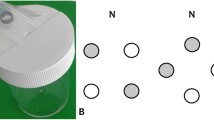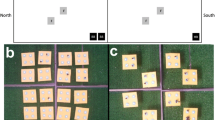Summary
Foraging bumblebees (Bombus vosnesenskii) deposit a substance on rewarding flowers which assists in discrimination between rewarding and nonrewarding flowers in a controlled laboratory environment. Discrimination occurs while the bee is on a flower; workers probe rewarding flowers as well as empty ones that have rewarded in the recent past, but they do not probe flowers that have had no reward. Recognition is not the result of honey contamination left on the flower by the bee during feeding. The deposit is only slightly soluble in water or ethyl alcohol but is very soluble in pentane.
Similar content being viewed by others
References
Brian AD (1951) The pollen collected by bumblebees. J Anim Ecol 20:191–194
Brian AD (1952) Division of labour and foraging in Bombus agrorum Fabricius. J Anim Ecol 21:223–240
Butler CG (1951) The importance of perfume in the discovery of food by the worker honeybee. Proc R Soc Lond [Biol] 138:403–413
Butler CG (1969) Nest-entrace marking with pheromones by the honeybee Apis mellifera L., and by a wasp, Vespula vulgaris L. Anim Behav 17:142–147
Cederberg B (1977) Evidence for trail marking in Bombus terrestris workers (Hymenoptera, Apidae). Zoon 5:143–146
Frankie G, Vinson SB (1977) Scent-marking of passion flowers in Texas by females of Xylocopa virginica texana (Hym: Anthophoridae). J Kans Entomol Soc 50:613–625
Free JB (1970) The flower constancy of bumble bees. J Anim Ecol 39:395–402
Frisch K von (1967) The dance language and orientation of bees. Belknap Press, Cambridge, MA
Johnson LD, Hubbell SP (1974) Aggression and competition among stingless bees: field studies. Ecology 55:120–127
Michener CD (1974) Social behavior of bees. Belknap Press, Harvard University, Cambridge, MA
Pyke G (1978) Optimal foraging: movement patterns of bumble-bees between inflorescences. Theor Popul Biol 13:72–98
Ribbands CR (1955) Scent perception of the honey bee. Proc R Soc Lond [Biol] 143:367–379
Schwarz R (1955) Über die Riechschärfe der Honigbiene. Z Vergl Physiol 37:180–210
Svensson B, Bergström G (1977) Volatile marking secretions from the labial gland of north european Pyrobombus males (Hymenoptera, Apidae). Insectes Soc 24:213–224
Author information
Authors and Affiliations
Rights and permissions
About this article
Cite this article
Cameron, S.A. Chemical signals in bumble bee foraging. Behav Ecol Sociobiol 9, 257–260 (1981). https://doi.org/10.1007/BF00299880
Received:
Accepted:
Issue Date:
DOI: https://doi.org/10.1007/BF00299880




